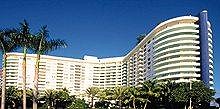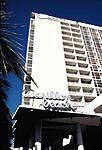Beyond Tiki, Bilge, and Test / Beyond Tiki / Miami Beach Mid-Century Modern officially historic
Post #352358 by I dream of tiki on Tue, Jan 1, 2008 5:49 PM
|
IDOT

I dream of tiki
Posted
posted
on
Tue, Jan 1, 2008 5:49 PM
"Make Way for/ MiMo"
In William Gibson’s 1980s cyberpunk classic “The Gernsbach Continuum,” the protagonist finds himself transported to an alternate reality created by nostalgia for the future that never was—the technotronic future of the Jetsons, where robots fold the laundry, the economy prospers, the children are safe, and the family hovercraft swoops past gleaming city infrastructures. By the 1980s, this romantic future had already proven itself an abortive dream emanating from a nostalgic past. But after WWII, in an era of prosperity and optimism since unparalleled, the dream was only beginning. Automobiles with soaring fins tacitly sliced through the air with graceful ease; sparkling new appliances promising to alleviate housework appeared in every kitchen. The combination of affordable automobiles, increased disposable income, and more leisure time proved irresistible, and Americans began to vacation as never before. Perhaps nowhere was the postwar craving for the futuristic more evident than on Miami Beach where, during the 1950s and 1960s, wildly inventive hotel designs emerged to satiate the requirements of the prosperous new middle-class on vacation. Resort area architects attempted to realize through their buildings what we of a more cynical age now concede to be science fiction. These architects created a unique futuristic look in Miami Beach that became known as Miami Modern—MiMO. The name MiMO was created two years ago by Randall Robinson, a planner with the Miami Beach Community Development Corporation, and Teri D’Amico, an interior designer and adjunct professor of hotel design at FIU, to refer to the hotel architecture of Greater Miami built between 1945-1969. The most famous architect of this style is Morris Lapidus, whose Fontainebleau, Eden Roc, Seacoast Towers, Deauville, and Di Lido, although typically considered Art Deco, are actually prime examples of MiMO. Naturally, the idea of MiMO did not spring up from the sea full-fledged; it has its roots in the Bauhaus movement of early 20th-century Germany, as propounded by architects and designers whose ideas soon made their way overseas: Walter Gropius, Le Corbusier, Mies van der Rohe, and Marcel Breuer. Their conception was in its own way also nostalgically futuristic: they dreamed of streamlined, non-ornamental buildings that were comfortable, functional, and could be enjoyed by the working class, whose values, the Bauhaus school sentimentally believed, had not been corrupted by the overwrought aesthetic of the bourgeoisie. How wrong they were.
The pure Bauhaus vision failed in the United States on every level: working-class people certainly didn’t have the means to engage the services of a Bauhaus architect, and the booming middle-class was intent on showing off its money with as many flourishes as possible. After WW II, elite college campuses clamored for the Bauhaus style, known as Modern (Le Corbusier designed a building for Harvard, Breuer for Vassar), but elsewhere architects began adapting Modern to the prevailing mood of their clients. In Miami, this meant ornamentation galore, but in clean, geometric forms: Tropical Art Deco, a combination of streamlined moderne and the art deco of 1920s Paris. At first glance, it can be difficult to differentiate MiMO from Art Deco. “We fall into a little bit of a trap when we make these distinctions,” admits Robinson of the MBCDC. “Anything old and vaguely decorative is called Art Deco.” Although there seem to be many similarities, MiMO comes closer to Modern in its use of certain features like asymmetry; kidney-bean and oval shapes and curves; carports with angular, amoeba-like, or winged shapes; semi-circular driveways at the entrance rather than front porches; and brise-soleils (sun shades). Although South Beach is almost exclusively filled with examples of Art Deco, some MiMO buildings do exist: the Miami Beach Fire Station Number 1 (11th and Jefferson), the 1688 Meridian Building, The Penguin Hotel (1418 Ocean Drive), The Shore Club (1801 Sunset Harbor Drive), The Di Lido (155 Lincoln Road), and Burdines (17th and Meridian). For the most part, however, MiMO architecture tends to congregate in mid and North Beach, Sunny Isles Beach, and Bay Harbor Islands. One architect who bridged the Art Deco-MiMO gap was Albert Anis, who created such Art Deco South Beach landmarks as the Clevelander, the Savoy, the Leslie, the Waldorf Towers, the Avalon and the Winter Haven before he moved on to his equally dramatic yet more organically shaped MiMO hotels of mid-beach, the Royal York (5875 Collins Ave.) and the Bel-Aire (6515 Collins). Both hotels were recently the subjects of community protests against developers and calls for preservation, to date without success -- the Bel-Aire’s façade has already been destroyed. Although preservationists are fighting the good fight, they are hampered by three harsh realities: (1) the current building code allows for far taller buildings than are currently standing, which is a boon for developers (2) The National Register of Historic Places, which would need to certify MiMO buildings in order to protect them from the wrecking ball, is unlikely to list properties younger than 50 years old unless they show “exceptional significance,” and (3) MiMO architecture is not universally considered to be of “exceptional significance.”
Even MiMO architect Morris Lapidus has weighed in against preservation; he was quoted in The New York Times as saying of the Bel-Aire, “Try living in a hotel like that. They were nice hotels for their time, but that time has passed.” Architect Norman Giller, who designed The Carillon (6801 Collins Ave.), lamented to The Miami Herald, “I think something needs to be done. It’s a crime the way [The Carillon’s] just sitting there. It’s an eyesore.” This particular eyesore won a Hotel of the Year award in 1957 for its distinctive glass façade and accordion wall in the ballroom. More than 40 years later, it stands abandoned. Fortunately for Giller, Robinson, D’Amico, and other would-be MiMO saviors, Miami Beach has a history of vigorous design preservation, and many of its most staunch preservationists are also politicians. The fight to save Art Deco is still relatively fresh in the minds of many commission and city council members, and they are likely to look with a favorable eye on pleas to save the old MiMO façades. In the meantime, nostalgia for the future lives on in Miami Beach, where we have the good fortune to be living in our very own Gernsbach Continuum. Article posted on Miami Beach USA |


 West Avenue, South Beach
West Avenue, South Beach The Carillon
The Carillon